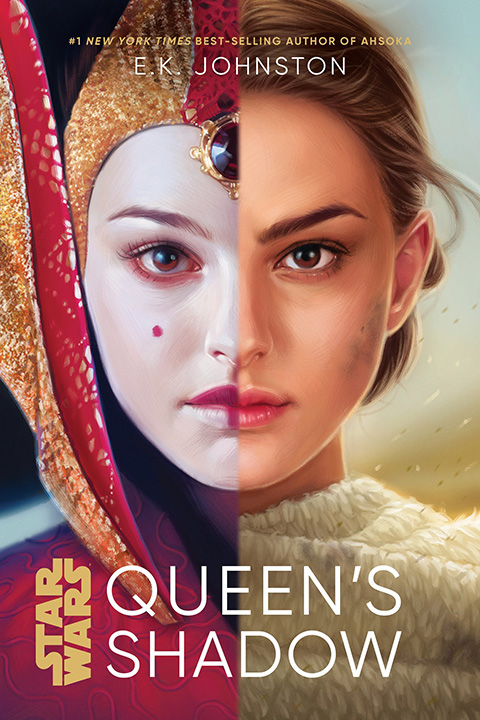Star Wars Beyond the Films‘ Nathan P. Butler is now posting short, non-spoiler reviews for many new releases. Spoiler-filled discussion will often follow in the weeks or months thereafter on the podcast.

Queen’s Shadow by E.K. Johnston (hardcover, 2019)
Disney Lucasfilm Press has been making a name for themselves among Star Wars fans with young adult novels that are often more meaningful, impactful on the saga, or just plain engaging than some of the recent adult novel fare from Del Rey. With works like Lost Stars and Rebel Rising setting a strong standard, how does Queen’s Shadow, the newest novel by Ahsoka scribe E.K. Johnston, fare when the focus shifts to Padmé Amidala?
Queen’s Shadow
First, let’s get one thing out of the way: Queen’s Shadow definitely wins the award for most accented E’s (é) in a single Star Wars novel, hands down. This is appropriate, of course, because this is not just Padmé’s story. It is also the story of her various handmaidens, both those we met in The Phantom Menace (e.g. Sabé) and those we would meet after this tale in Attack of the Clones (e.g. Cordé). As such, the novel has more é’s than Happy Days. (Yeah, I know, I may be the only one who chuckled at that, but at least that’s something, right?)
The story picks up as Padmé is about to end her time as Queen of Naboo, which will mean new paths forward for both the former monarch and her many handmaidens. As one might expect, this is cut short when Padmé is approached by the newly-elected queen to represent Naboo in the Galactic Senate. The novel then follows Padmé through her early days in the Senate, as she gets the lay of the land and meets various personalities from both the films and The Clone Wars.
While we do see Padmé face a few challenges once in the Senate, there really isn’t much of an action throughline or bombastic climax to the tale. This is a story more about character growth than clashes of galactic importance. That said, it is an enjoyable read. The amount we learn about the personalities, backgrounds, and relationships of the handmaidens will forever change how you see them in the films, and insights into Naboo politics and the techniques and technologies involved in how the handmaidens and queen persona protect Padmé will give you a greater appreciation for those elements of the films as well.
That said, as someone who enjoys both the current Story Group Canon and its long-running predecessor, the Legends Continuity, I would be remiss if I didn’t mention that the story does tend to change previously-understood aspects of Naboo politics. Terms as queen, for example, remain limited to two terms for any individual, but those terms are now two-year terms instead of lasting four years. Thus, Padmé is entering the Senate earlier than previously portrayed in Legends and put forward in her canonical background. The queen who replaces her and requests that she serve in the Senate is not Jamillia but a previously-unseen queen between Padmé and the queen we meet in AOTC. (This may be an attempt to retcon how we could see yet another previously-unseen queen, Neeyutnee, in The Clone Wars when we already met Queen Apailana in 2005’s Revenge of the Sith.) On the other hand, it does fill in plenty of gaps in our canonical knowledge, such as learning the canonical reason for why Quarsh Panaka isn’t around in AOTC, replaced by his nephew, Gregar Typho.
Lastly, I should note that if you have the time to go through the audiobook version of Queen’s Shadow instead of the print version, the audio version is read by Cat Taber, the voice of Padmé in The Clone Wars, which should be a treat.
The Verdict
I was not particularly looking foward to Queen’s Shadow, and its lack of action/adventure definitely makes this one that isn’t going to be for everyone. However, with my interest in politics (one of the subjects I teach), I found the novel interesting enough that even when my Continuity/Chronology Alarms were going off about things like Naboo queen tenure, I was able to get into this one a bit more than I had been able to get into Most Wanted or Leia: Princess of Alderaan. It certainly altered and improved my perception of Padmé’s handmaidens and wardrobe.
It is nice to see Padmé get her own book, which serves the character better than most recently in Thrawn: Alliances. It just won’t necessarily be something the more action-seeking side of fandom will want to check out. For others, like me, it made for a nice change of pace.
Recommended for: Those interested in Naboo politics, Padmé’s growth between TPM and AOTC, or the handmaidens.
Not recommended for: Those who want an action-packed, adventure-filled Star Wars tale.
The copy used for this review was provided by Disney Lucasfilm Press, as was an uncorrected proofs copy, though the reviewer had a copy on preorder anyway.
